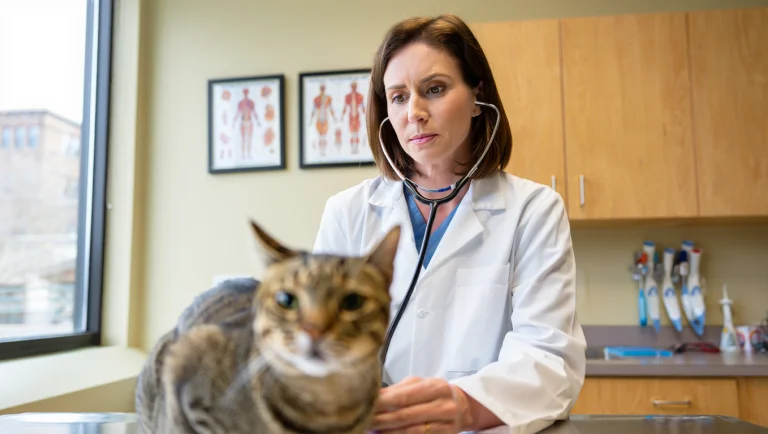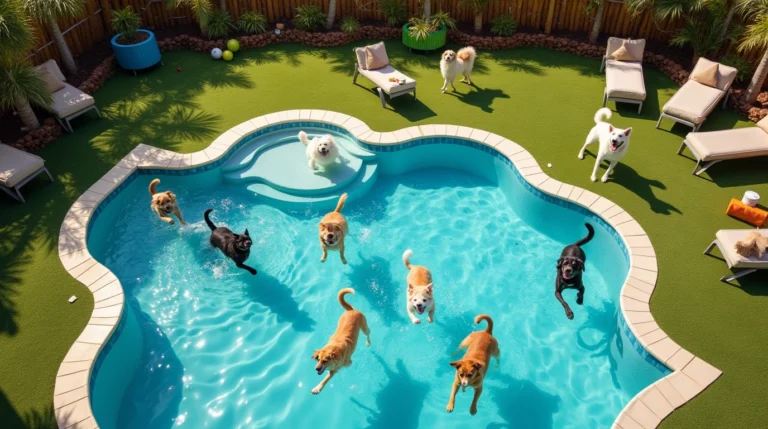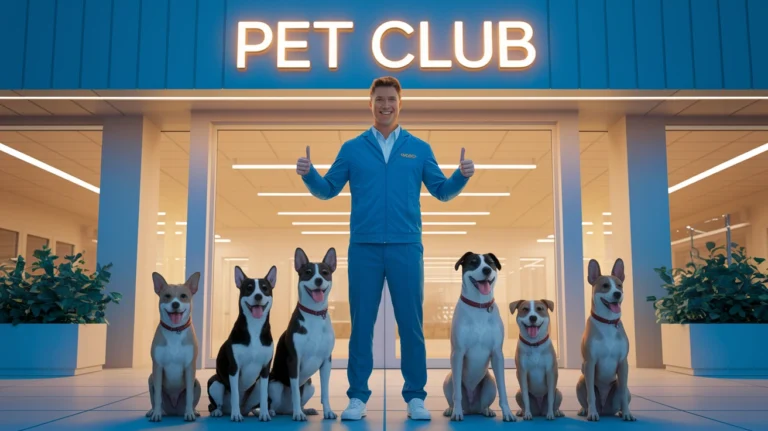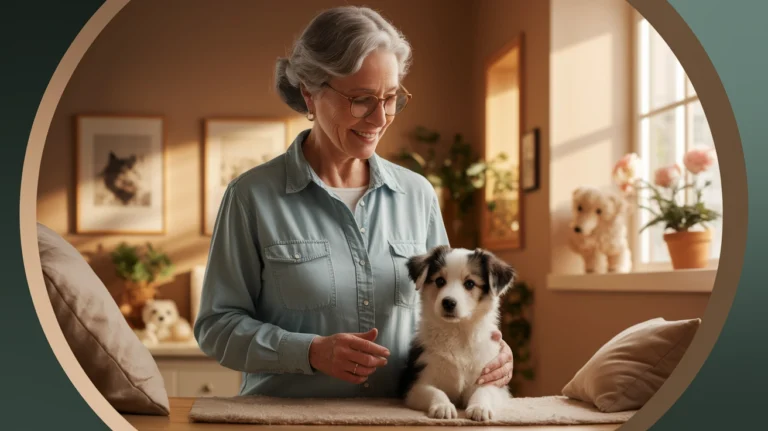Discover the truth about cats with Down syndrome in this expert guide. Learn about common myths, real conditions, and how to care for special needs felines.
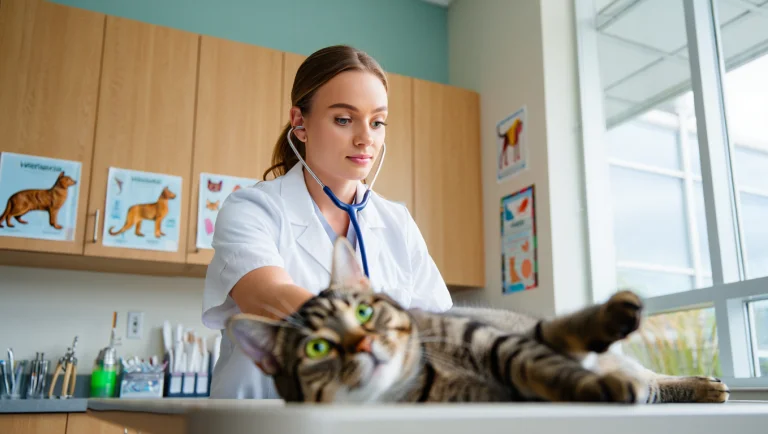
Table of Contents
Have you ever scrolled through social media and come across adorable cats with unique facial features, sometimes labeled as “cats with Down syndrome”? These charming felines with their distinctive appearances often capture our hearts, but there’s significant confusion surrounding this topic. As a devoted cat parent, understanding the truth about these special cats is crucial for proper care and respect.
The term “cats with Down syndrome” has gained popularity online, but it represents a fundamental misunderstanding about feline genetics and health. Today, we’re diving deep into this topic to separate fact from fiction and provide you with accurate, evidence-based information about cats with Down syndrome-like features.
In this comprehensive guide, we’ll explore the shocking myths about so-called “cats with Down syndrome,” explain what’s really happening with these special felines, and provide valuable insights for anyone caring for a cat with unusual physical or developmental characteristics.

Understanding the Basics: Can Cats Actually Have Down Syndrome?
Before we dive into the myths, let’s establish some fundamental facts about Down syndrome and how it relates to our feline friends.
What Is Down Syndrome in Humans?
Down syndrome is a genetic condition that occurs in humans when there’s an extra copy (full or partial) of chromosome 21. This chromosomal anomaly causes developmental changes and physical features that are characteristic of Down syndrome, including:
- Flattened facial features
- Almond-shaped eyes that slant upward
- A short neck
- Small ears
- Poor muscle tone
- Broad, short hands with a single crease in the palm
- Relatively short height
The Feline Chromosome Count
Here’s where we encounter our first major difference: humans have 23 pairs of chromosomes (46 total), while cats have 19 pairs (38 total). Down syndrome in humans specifically involves chromosome 21, but cats don’t have an equivalent chromosome.
Expert Insight: Dr. Leslie Lyons, a professor at the University of Missouri College of Veterinary Medicine and expert in feline genetics, explains: “Cats cannot have Down syndrome as it’s specifically a trisomy of human chromosome 21, which cats don’t have. What people are seeing are other genetic conditions or developmental issues that may present with somewhat similar physical characteristics.”
Myth #1: Cats Can Have Down Syndrome Just Like Humans
The Myth: Many social media posts and even some pet websites claim that cats can have the same Down syndrome condition that affects humans.
The Reality: Cats cannot have Down syndrome. Down syndrome is a specific human condition involving an extra copy of chromosome 21. Since cats have a different chromosome count and structure, they simply cannot have this specific condition.
What’s Actually Happening?
Cats that display physical or behavioral characteristics sometimes attributed to “Down syndrome” are actually experiencing:
- Other genetic conditions: Cats can have various genetic mutations that affect their appearance and development.
- Congenital disorders: Some cats are born with developmental issues that aren’t genetic but occurred during fetal development.
- Infections during pregnancy: Certain infections the mother cat experiences during pregnancy can affect kitten development.
- Trauma during birth: Oxygen deprivation or physical trauma during birth can lead to developmental issues.
- Exposure to toxins: Either in utero or after birth, toxin exposure can cause neurological symptoms and physical abnormalities.
Case Study: Monty the Cat
One of the internet’s most famous cats with supposed “Down syndrome” is Monty, who has over 200,000 followers on social media. Monty was born without a nasal bridge bone, giving him a distinctive appearance. His condition is a specific congenital abnormality, not Down syndrome. Despite his different appearance, Monty lives a happy, healthy life with his adopted family.
Myth #2: All Cats With Unusual Facial Features Have the Same Condition
The Myth: Many people assume that all cats with flattened faces, widely spaced eyes, or other unusual facial features have the same condition.
The Reality: There are numerous distinct genetic and developmental conditions that can cause unusual facial features in cats.
Common Conditions That Cause Down Syndrome-Like Features in Cats:
1. Chromosomal Abnormalities
While cats can’t have Down syndrome specifically, they can have other chromosomal abnormalities. These are relatively rare but can cause developmental issues and physical differences.
2. Cerebellar Hypoplasia
This neurological condition affects a cat’s motor skills and coordination but doesn’t impact cognitive function. Cats with cerebellar hypoplasia often have:
- Uncoordinated movements
- Head tremors
- Intention tremors (shaking when attempting to make deliberate movements)
It’s caused by underdevelopment of the cerebellum, usually due to the mother cat contracting feline panleukopenia virus during pregnancy.
3. Hydrocephalus
This condition involves an abnormal buildup of cerebrospinal fluid within the brain, causing:
- Dome-shaped head
- Wide-set eyes
- Potential cognitive impairments
- Coordination problems
4. Feline Dysautonomia (Key-Gaskell Syndrome)
This rare condition affects the autonomic nervous system and can cause:
- Droopy eyelids
- Dilated pupils
- Digestive issues
- Behavioral changes
5. Brachycephalic Breed Characteristics
Some breeds like Persians are intentionally bred to have flattened faces. This isn’t a disorder but a breed standard, though it can come with health challenges like:
- Breathing difficulties
- Eye problems
- Dental issues
Myth #3: Cats With These Conditions Always Have Intellectual Disabilities
The Myth: Many people assume that cats with unusual facial features or certain physical limitations must have cognitive impairments or intellectual disabilities.
The Reality: Physical characteristics don’t necessarily indicate cognitive abilities in cats. Many cats with unusual physical features have normal intelligence and simply face different physical challenges.
Understanding Feline Cognitive Function
Cats with conditions that affect their appearance may have completely normal cognitive function. Others might have specific cognitive challenges but still lead fulfilling lives with proper care.
Dr. Sophia Martinez, veterinary neurologist, notes: “We should be careful not to make assumptions about a cat’s cognitive abilities based solely on physical appearance. Many cats with congenital abnormalities are just as intelligent as any other cat—they simply process information or interact with their environment differently.”
Signs That Might Indicate Cognitive Differences in Cats:
- Difficulty learning litter box habits despite proper training
- Inability to recognize familiar people or pets
- Confusion about surroundings in familiar environments
- Poor adaptation to changes in routine
- Unusual vocalization patterns
- Altered sleep-wake cycles
Myth #4: These Special Cats Cannot Live Long, Happy Lives
The Myth: There’s a common misconception that cats with genetic abnormalities or developmental issues have significantly shorter lifespans and poor quality of life.
The Reality: While some conditions may come with health challenges, many cats with congenital abnormalities can live long, happy lives with proper care and accommodations.
Success Stories
Lil Bub: Perhaps one of the most famous cats with genetic abnormalities, Lil Bub lived for 8 years with multiple conditions including polydactyly (extra toes), extreme dwarfism, and osteopetrosis (dense bones). Despite these challenges, she lived a full life as an internet celebrity and helped raise over $700,000 for animal charities.
Otto the Odd: A cat with cerebellar hypoplasia who became an advocate for special needs pets, Otto lived to be 12 years old. His owners created specialized feeding stations and modified play areas to accommodate his wobbliness.
Quality of Life Considerations
When caring for a cat with special needs, consider these quality of life factors:
- Is the cat able to eat, drink, and use the litter box with reasonable accommodations?
- Does the cat show interest in environment and interaction?
- Is the cat relatively comfortable and not in chronic pain?
- Can the cat engage in natural behaviors like grooming, playing, and resting?
Myth #5: Special Needs Cats Require Prohibitively Expensive Care
The Myth: Caring for cats with genetic or developmental conditions is always extremely costly and beyond the means of average pet owners.
The Reality: While some cats with special needs do require additional veterinary care or accommodations, many can be cared for with simple, affordable modifications to their environment and routine.
Cost-Effective Care Tips for Special Needs Cats
1. Environmental Modifications
- Use baby gates to block dangerous areas
- Add steps or ramps to favorite perches
- Place litter boxes and food dishes in easily accessible locations
- Use non-slip mats under food and water bowls for wobblier cats
2. Preventative Care
- Regular veterinary check-ups can catch issues early
- Maintaining appropriate weight can prevent additional stress on joints
- Dental care is especially important for cats with facial abnormalities
3. Specialized Equipment
- Harnesses for cats with balance issues
- Raised food bowls for cats with certain structural abnormalities
- Special grooming tools for cats who have difficulty self-grooming
4. Community Resources
- Many communities have special needs pet support groups
- Some veterinary schools offer reduced-cost care for cases of educational value
- Online communities can provide advice and emotional support
Real-World Example: The Jackson Galaxy Project’s “Cat Pawsitive” program works with shelter cats, including those with special needs, to improve adoptability and quality of life through positive reinforcement training techniques.

How to Care for a Cat With Special Needs
If you’ve adopted or are considering adopting a cat with physical or developmental differences, here are some comprehensive guidelines to provide the best care possible:
1. Get an Accurate Diagnosis
Understanding exactly what condition(s) your cat has is crucial for providing appropriate care.
- Seek out a veterinarian with experience in feline congenital conditions
- Consider genetic testing if appropriate and available
- Obtain referrals to specialists when needed (neurology, ophthalmology, etc.)
2. Create a Safe Environment
Cats with mobility or sensory issues need environments tailored to their needs:
- Remove hazards like sharp corners or objects that could be knocked over
- Provide multiple levels of accessibility for favorite spots
- Consider textured surfaces for cats with vision impairments
- Use nightlights for cats with poor vision
- Keep a consistent layout that doesn’t change frequently
3. Develop a Specialized Diet Plan
Some genetic conditions may require dietary modifications:
- Consult with a veterinary nutritionist if possible
- Consider texture and kibble size for cats with facial abnormalities
- For cats with gastrointestinal issues, special diets may be necessary
- Ensure easy access to fresh water at all times
4. Establish a Consistent Routine
Cats with neurological differences often thrive with predictability:
- Feed at the same times daily
- Play sessions at regular intervals
- Consistent sleep schedule
- Medication administration at the same times each day
5. Provide Appropriate Enrichment
All cats need mental stimulation, but it may need to be modified for cats with special needs:
- Puzzle feeders adjusted for physical capabilities
- Scent enrichment for cats with visual impairments
- Sound toys for visually impaired cats
- Modified play that accounts for mobility limitations
6. Monitor for Changes
Cats with congenital conditions may be more vulnerable to secondary issues:
- Keep a health journal to track patterns
- Note changes in behavior, appetite, or elimination habits
- Schedule regular veterinary check-ups, potentially more frequent than for typical cats
- Be aware of signs that might indicate pain or discomfort
Common Conditions Mistaken for “Feline Down Syndrome”
To help identify specific conditions your special cat might have, let’s explore some of the most common conditions that are mistakenly labeled as “feline Down syndrome.”
1. Feline Cerebellar Hypoplasia (CH)
What it is: An underdevelopment of the cerebellum, the part of the brain that controls fine motor skills and coordination.
Common signs:
- Jerky, uncoordinated movements
- Head tremors
- Intention tremors (trembling when attempting to perform an action)
- Wide-legged stance for stability
- May fall over when walking or running
What causes it: Usually the result of the mother cat being infected with feline panleukopenia virus during pregnancy, or sometimes from trauma or malnutrition in utero.
Important note: This is a non-progressive condition, meaning it doesn’t get worse over time. Cats with CH are not in pain and can adapt remarkably well to their mobility challenges.
2. Hydrocephalus
What it is: An abnormal accumulation of cerebrospinal fluid within the brain.
Common signs:
- Dome-shaped or enlarged head
- Persistent fontanelle (soft spot on the skull)
- Wide-set eyes
- Difficulty in training
- Seizures in some cases
- Possible vision problems
- Behavioral changes
What causes it: Can be congenital (present at birth) or acquired from trauma, infection, or tumors.
Treatment options: May include medications to reduce fluid production, shunts to drain excess fluid in severe cases, and supportive care.
3. Klinefelter Syndrome (XXY Chromosomes)
What it is: A genetic condition where male cats have an extra X chromosome.
Common signs:
- Orange and black patches in male cats (tortoiseshell or calico patterns, which are typically only seen in females)
- Possible developmental abnormalities
- Potential sterility
What causes it: A genetic mutation present at conception.
Important note: This is one of the few true chromosomal abnormalities that can occur in cats, though it’s different from Down syndrome.
4. Facial Deformities
What it is: Various congenital or developmental abnormalities affecting facial structure.
Common signs:
- Shortened nasal bridge
- Wide-set eyes
- Unusual ear placement
- Jaw misalignment
What causes it: Can result from genetic mutations, in utero trauma, or exposure to certain toxins during development.
5. Feline Dysautonomia (Key-Gaskell Syndrome)
What it is: A disorder affecting the autonomic nervous system.
Common signs:
- Dilated pupils that respond poorly to light
- Droopy eyelids
- Protrusion of the third eyelid
- Dry eyes and nose
- Difficulty swallowing
- Vomiting or regurgitation
- Constipation
- Urinary incontinence
What causes it: The exact cause remains unknown, though theories include exposure to toxins or infectious agents.
Ethical Considerations: Social Media and Special Needs Cats
The rise of social media has created both opportunities and challenges for cats with special needs.
The Positive Impact
- Increased awareness and adoption rates for special needs cats
- Community support for owners facing similar challenges
- Fundraising opportunities for cats needing specialized medical care
- Education about various feline conditions
The Ethical Concerns
- Misrepresentation of conditions (like calling them “Down syndrome cats”)
- Potential exploitation of cats’ conditions for views or followers
- Risk of people seeking out cats with abnormalities for social media fame
- Reinforcement of misconceptions about feline health and genetics
Expert Perspective: Animal ethicist Dr. James Thompson notes, “While the visibility of special needs pets on social media has done wonders for adoption rates, we must be careful not to romanticize disabilities or spread misinformation. Educational content that accurately represents these conditions is invaluable, but content that sensationalizes or misrepresents them can be harmful.”
How to Support Special Needs Cat Rescues and Research
If you’re moved by the stories of cats with special needs, there are numerous ways to help:
1. Volunteer or Foster
- Many rescues need help socializing special needs cats
- Fostering provides crucial information about how a cat might adapt to home life
- Short-term care during recovery periods is especially valuable
2. Donate
- Financial contributions to specialized rescues
- Supplies like specialized feeding equipment, ramps, or medical items
- Professional services (web design, photography, grant writing)
3. Advocate
- Share accurate information about feline conditions
- Support research initiatives studying feline genetic conditions
- Promote positive, educational content about special needs cats
4. Adopt
- Consider adding a special needs cat to your family
- Special needs cats often wait much longer for homes
- Many have very manageable conditions that require minimal additional care
For more expert pet care tips and product recommendations, visit BlithePet.com — your trusted source for pet wellness.
FAQ: Common Questions About Cats With Unique Needs
Q: Can cats actually have Down syndrome?
A: No, cats cannot have Down syndrome. Down syndrome is specifically a human condition involving an extra copy of chromosome 21. Cats have different chromosomal structures (19 pairs versus 23 in humans) and don’t have an equivalent to human chromosome 21. Cats can have other genetic conditions or developmental issues that may present with somewhat similar physical characteristics.
Q: What causes the facial features that make people think a cat has “Down syndrome”?
A: Several conditions can cause facial features sometimes mistakenly attributed to “Down syndrome,” including:
- Congenital malformations of the facial bones
- Hydrocephalus (fluid buildup in the brain)
- Infections that affected development during pregnancy
- Genetic mutations specific to cats
- Trauma during birth or development
Q: Do cats with these conditions have shorter lifespans?
A: It depends entirely on the specific condition. Some congenital conditions may impact lifespan, while others have minimal effect. Cats with cerebellar hypoplasia, for example, often have normal lifespans. Each case is unique, and with proper veterinary care, many cats with congenital conditions can live long, fulfilling lives.
Q: Are cats with special needs more expensive to care for?
A: Some special needs cats require additional veterinary care or accommodations, which can increase costs. However, many only need simple, affordable modifications to their environment. It’s important to get a clear understanding of a specific cat’s needs before adoption. Pet insurance that covers congenital conditions can help manage unexpected expenses.
Q: Can cats with conditions like cerebellar hypoplasia or hydrocephalus live happy lives?
A: Absolutely! Many cats with these conditions adapt remarkably well and enjoy playing, cuddling, and engaging in normal feline behaviors. They may do things differently but can experience excellent quality of life with appropriate accommodations and care.
Q: How do I know if a cat with special needs is the right fit for my home?
A: Consider factors like:
- Your schedule and availability for additional care if needed
- Your living environment and whether accommodations can be made
- Your financial ability to handle potential medical costs
- Your experience level with cats in general
- Consulting with the shelter, rescue, or veterinarian about specific care requirements
Conclusion
Understanding the reality behind cats with Down syndrome helps us provide better care for felines with special needs and dispel harmful myths. While cats cannot have Down syndrome as humans do, they can have various genetic, developmental, or congenital conditions that create unique appearances and sometimes special care requirements.
Each of these special cats is an individual with their own personality, capabilities, and needs. By focusing on accurate information rather than misleading labels, we can ensure these wonderful companions receive the understanding, care, and respect they deserve.
The next time you see a cat with unique facial features or developmental differences, remember that they’re not a “Down syndrome cat” but rather a cat with their own specific condition—one that likely doesn’t define them any more than your own unique characteristics define you.
These special felines remind us that differences are to be celebrated, understood, and accommodated rather than misunderstood or misrepresented. With proper care and attention to their individual needs, cats with congenital conditions can thrive and bring immeasurable joy to their human companions.
Have a similar experience with your special needs cat? Share it in the comments below!

